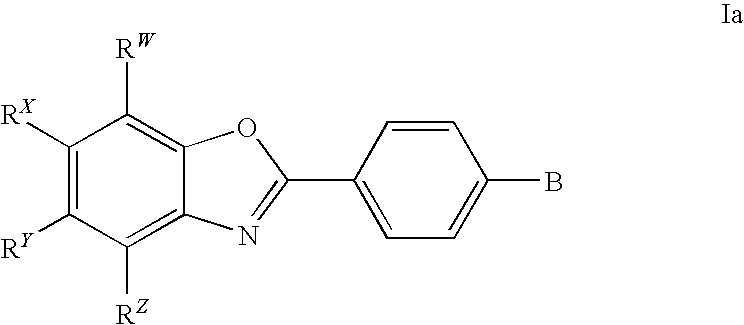CETP inhibitors
a technology of hdl-c and inhibitors, applied in the field of ccetp inhibitors, can solve the problems of chd risk, high risk of chd, and low serum hdl-c level, and achieve the effect of only achieving a risk reduction of approximately one-third
- Summary
- Abstract
- Description
- Claims
- Application Information
AI Technical Summary
Benefits of technology
Problems solved by technology
Method used
Image
Examples
example 1
[0213]
N-[4-(5-chloro-1,3-benzoxazol-2-yl)phenyl]-2-(3-fluorophenoxy)acetamide
[0214]A solution of 5.3 μL of 3-fluorophenol, 10.2 mg of potassium carbonate, and 18 mg of 2-bromo-N-[4-(5-chloro-1,3-benzoxazol-2-yl)phenyl]acetamide (INTERMEDIATE 2) in 1 mL of DMF was stirred overnight at r.t., and then diluted with 10 mL of water. The precipitate was collected by filtration, dissolved in chloroform, and purified by flash column chromatography on a Biotage Horizon, 25S column, eluting with 1 column volume of 1% EtOAc in CH2Cl2, followed by a linear gradient of EtOAc in CH2Cl2 from 1 to 100% over 10 column volumes to provide the title compound. Mass spectrum (ESI) 397.1 (M+1). 1H NMR (500 MHz, CDCl3): δ 8.38, (s, 1H), 8.23 (dd, J=2, 7 Hz, 2H), 7.79 (dd, J=2, 7 Hz, 2H), 7.72 (s, 1H), 7.49 (d, J=8.5 Hz, 1H), 7.30-7.33 (m, 2H), 6.74-6.81 (m, 3H), 4.64 (s, 2H).
example 2
[0215]
N-[4-(5-chloro-1,3-benzoxazol-2-yl)phenyl]-N2-phenylglycinamide
[0216]A solution of 13 μL of aniline, 29 μL of diisopropylethylamine, and 47 mg of 2-bromo-N-[4-(5-chloro-1,3-benzoxazol-2-yl)phenyl]acetamide (INTERMEDIATE 2) in 1 mL of DMSO was stirred for 3 days at r.t., and then filtered and purified by reverse-phase HPLC on a Metachem Basic C8 21×100 mm column, eluting at 20 mL / min with a gradient of 30%) in water (0.1% TFA) to 100% acetonitrile (0.1% TFA over 8 min to yield the title compound. Mass spectrum (ESI) 378.1 (M+1). 1H NMR (500 MHz, CD3OD): δ 8.18 (d, J=9 Hz, 2H), 7.82 (d, J=9 Hz, 2H), 7.70 (d, 2.5 Hz, 1H), 7.63 (d, J=8.5 Hz, 1H), 7.38 (dd, 2, 8.5 Hz, 1H), 7.18-7.22 (m, 2H), 6.77-6.82 (m, 3H), 4.00 (s, 2H).
example 3
[0217]
N-[4-(5-chloro-1,3-benzoxazol-2-yl)phenyl]-2-(cyclohexcyloxy)acetamide
[0218]Following the procedure described in EXAMPLE 8, 35 mg of (cyclohexyloxy)acetic acid, 89 μL of a 2M solution of oxalyl chloride in CH2Cl2, 54 mg of 4-(5-chloro-1,3-benzoxazol-2-yl)aniline (INTERMEDIATE 1) and 39 μL of diisopropylethylamine provided the title compound. Mass spectrum (ESI) 385.1 (M+1). 1H NMR (500 MHz, DMSO): δ 9.97, (s, 1H), 8.14 (d, J=9 Hz, 2H), 7.91 (d, J=9 Hz, 2H), 7.87 (d, J=2 Hz, 1H), 7.79 (d, J=8.5 Hz, 1H), 7.43 (dd, J=2.5, 9 Hz, 1H), 4.10 (s, 2H), 3.38 (m, 1H), 1.89-1.92 (m, 2H), 1.67-1.70 (m, 2H), 1.47-1.50 (m, 1H), 1.17-1.33 (m, 5H).
Intermediate 3
[0219]
2-(4-aminophenyl)-1,3-benzoxazole-5-carbonitrile
Step A. 3-amino-4-hydroxybenzonitrile
[0220]To a suspension of 10.0 g of 4-hydroxy-3-nitrobenzonitrile and 19.0 g of ammonium formate in 150 mL of MeOH was added portionwise 1.0 g of 10% palladium on carbon. The mixture spontaneously refluxed after addition of the catalyst was complet...
PUM
| Property | Measurement | Unit |
|---|---|---|
| density | aaaaa | aaaaa |
| volume | aaaaa | aaaaa |
| volume | aaaaa | aaaaa |
Abstract
Description
Claims
Application Information
 Login to View More
Login to View More - R&D
- Intellectual Property
- Life Sciences
- Materials
- Tech Scout
- Unparalleled Data Quality
- Higher Quality Content
- 60% Fewer Hallucinations
Browse by: Latest US Patents, China's latest patents, Technical Efficacy Thesaurus, Application Domain, Technology Topic, Popular Technical Reports.
© 2025 PatSnap. All rights reserved.Legal|Privacy policy|Modern Slavery Act Transparency Statement|Sitemap|About US| Contact US: help@patsnap.com



